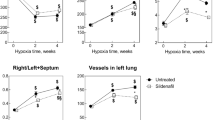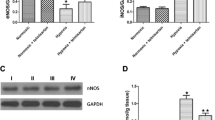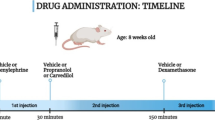Abstract
Right ventricular hypertrophy induced by chronic hypoxia is mainly due to a mechanical stress upon the ventricular wall secondary to pulmonary arterial hypertension. However, the hypoxic chronic activation of the sympathetic nervous system can contribute to the development of right ventricular hypertrophy either via myocardial adrenergic receptors and/or a vasoconstriction and remodeling of pulmonary arteries. To highlight the specific role of the sympathetic nervous system on hypoxia-induced right ventricular hypertrophy and particularly the efficiency of carvedilol, our study compared physiological, myocardial, and pulmonary arterial morphometric data in rats treated by α-(prazosin), or β-(propranolol) or αβ-(carvedilol) antagonist and exposed to chronic hypobaric hypoxia (2 weeks at 380 mmHg barometric pressure). In chronic hypoxia, both systolic right ventricular pressure and Fulton’s ratio (right/(left+septum) ventricular weight) were lower in rats treated by prazosin (−16.7 and −13.6%), propranolol (−28.6 and −12.7%) and carvedilol (−15.9 and −14.3%) respectively when compared to glucose (p<0.05). Surprisingly, prazosin was unable to reduce right ventricular hypertrophy induced by chronic hypoxia, whereas, left ventricular weight increased. Wall thickness index of pulmonary arteries increased in chronic hypoxia and was reduced by carvedilol. In conclusion, the hypoxia-induced activation of the adrenergic system participates in the development of right ventricular hypertrophy. Carvedilol is effective in reducing hypoxia-induced right ventricular hypertrophy, pulmonary arterial hypertension, and muscularization of pulmonary arteries.




Similar content being viewed by others
References
Asai T, Kushiro T, Fujita H, Kanmatsuse K (2005) Different effects on inhibition of cardiac hypertrophy in spontaneously hypertensive rats by monotherapy and combination therapy of adrenergic receptor antagonists and/or the angiotensin II type 1 receptor blocker under comparable blood pressure reduction. Hypertens Res 28:79–87
Autelitano DJ, Woodcock EA (1998) Selective activation of α1a-adrenergic receptors in neonatal cardiac myocytes is sufficient to cause hypertrophy and differential regulation of α1-adrenergic receptor subtype mRNAs. J Mol Cell Cardiol 30:1515–1523
Azevedo ER, Kubo T, Mak S, Al-Hesayen A, Schofield A, Allan R, Kelly S, Newton GE, Floras JS, Parker JD (2001) Nonselective vs selective β-adrenergic receptor blockade in congestive heart failure: differential effects on sympathetic activity. Circulation 104:2194–2199
Braun MU, Szalai P, Strasser RH, Borst MM (2003) Right ventricular hypertrophy and apoptosis after pulmonary artery banding: regulation of PKC isozymes. Cardiovasc Res 59:658–667
Brimioulle S, Vachiery JL, Brichant JF, Delcroix M, Lejeune P, Naeije R (1997) Sympathetic modulation of hypoxic pulmonary vasoconstriction in intact dogs. Cardiovasc Res 34:384–392
Cleland JG (1999) Progression from hypertension to heart failure. Mechanisms and management. Cardiology 92(Suppl 1):10–21
Cooper G 4th (1997) Basic determinants of myocardial hypertrophy: a review of molecular mechanisms. Annu Rev Med 48:13–23
DiCarlo VS, Chen SJ, Meng QC, Durand J, Yano M, Chen YF, Oparil S (1995) ETA-receptor antagonist prevents and reverses chronic hypoxia-induced pulmonary hypertension in rat. Am J Physiol 269(5 pt 1):L690–697
Favret F, Henderson KK, Clancy RL, Richalet JP, Gonzalez NC (2001) Exercise training alters the effect of chronic hypoxia on myocardial adrenergic and muscarinic receptor number. J Appl Physiol 91:1283–1288
Favret F, Richalet JP, Henderson KK, Germack R, Gonzalez NC (2001) Myocardial adrenergic and cholinergic receptor function in hypoxia: correlation with O2 transport in exercise. Am J Physiol Regul Integr Comp Physiol 280:R730–R738
Favret F, Henderson KK, Richalet JP, Gonzalez NC (2003) Effects of exercise training on acclimatization to hypoxia: systemic O2 transport during maximal exercise. J Appl Physiol 95:1531–1541
Fedida D, Bouchard RA (1992) Mechanisms for the positive inotropic effect of alpha 1-adrenoceptor stimulation in rat cardiac myocytes. Circ Res 71:673–688
Feuerstein G, Yue TL, Ma X, Ruffolo RR (1998) Novel mechanisms in the treatment of heart failure: inhibition of oxygen radicals and apoptosis by carvedilol. Prog Cardiovasc Dis 41(Suppl 1):17–24
Gottdiener JS, Reda DJ, Massie BM, Materson BJ, Williams DW, Anderson RJ (1997) Effect of single-drug therapy on reduction of left ventricular mass in mild to moderate hypertension: comparison of six antihypertensive agents. The department of veterans affairs cooperative study group on antihypertensive agents. Circulation 95:2007–2014
Greenberg B (2004) Non-selective versus selective β-blockers in the management of chronic heart failure: clinical implications of the carvedilol or metoprolol European trial. Rev Cardiovasc Med 5(Suppl 1):10–17
Hoshikawa Y, Ono S, Suzuki S, Tanita T, Chida M, Song C, Noda M, Tabata T, Voelkel NF, Fujimura S (2001) Generation of oxidative stress contributes to the development of pulmonary hypertension induced by hypoxia. J Appl Physiol 90:1299–1306
Ikeda U, Tsuruya Y, Yaginuma T (1991) Alpha1-adrenergic stimulation is coupled to cardiac myocyte hypertrophy. Am J Physiol 260:H953–H956
Ishibashi Y, Rembert JC, Carabello BA, Nemoto S, Hamawaki M, Zile MR, Greenfield JC Jr, Cooper G 4th (2001) Normal myocardial function in severe right ventricular volume overload hypertrophy. Am J Physiol 280:H11-H16
Kacimi R, Richalet JP, Corsin A, Abousahl I, Crozatier B (1992) Hypoxia-induced downregulation of β-adrenergic receptors in rat heart. J Appl Physiol 73:1377–1382
Kaye AD, Hoover JM, Baber SR, Ibrahim IN, Fields AM (2004) Effects of norepinephrine on alpha-subtype receptors in the feline pulmonary vascular bed. Crit Care Med 32:2300–2303
Morel OE, Buvry A, Le Corvoisier P, Tual L, Favret F, León-Velarde F, Crozatier B, Richalet JP (2003) Effects of nifedipine-induced pulmonary vasodilatation on cardiac receptors and protein kinase C isoforms in the chronically hypoxic rat. Pflugers Arch 446:356–364
Moret PR, Duchosal F (1976) Effects of propranolol on pulmonary hypertension, right ventricular hypertrophy and metabolic myocardial changes due to acute hypoxemia due to high altitude. Schweiz Med Wochenschr 106:1564–1566
Nakamoto T, Harasawa H, Momoki S, Suzuki H, Horie Y, Ohnuma N, Ohno K, Kato S, Okuda M, Iizuka M (1997) Long-term effects of a selective alpha 1-adrenergic inhibitor on right and left ventricular masses in patients with chronic pulmonary disease. Nihon Kyobu Shikkan Gakkai Zasshi 35:30–37
Nouette-Gaulain K, Forestier F, Malgat M, Marthan R, Mazat JP, Sztark F (2002) Effects of bupivacaine on mitochondrial energy metabolism in heart of rats following exposure to chronic hypoxia. Anesthesiology 97:1507–1511
Ostadal B, Urbanova D, Ressl J, Prochazka J, Pelouch V, Widimsky J (1981) Changes of the right and left ventricles in rats exposed to intermittent high altitude hypoxia. Cor Vasa 23:111–120
Östman-Smith I (1995) Reduction by β-adrenoceptor blockade of hypoxia-induced right heart hypertrophy in the rat. Br J Pharmacol 116:2698–2702
Pacca SR, De Azevedo AP, De Oliveira CF, De Luca IM, De Nucci G, Antunes E (2002) Attenuation of hypertension, cardiomyocyte hypertrophy, and myocardial fibrosis by beta-adrenoceptor blockers in rats under long-term blockade of nitric oxide synthesis. J Cardiovasc Pharmacol 39:201–207
Rabinovitch M, Gamble W, Nadas AS, Miettinen OS, Reid L (1979) Rat pulmonary circulation after chronic hypoxia: hemodynamic and structural features. Am J Physiol 236:H818–H827
Richalet JP, Le-Trong JL, Rathat C, Merlet P, Bouissou P, Kéromès A, Veyrac P (1989) Reversal of hypoxia-induced decrease in human cardiac response to isoproterenol infusion. J Appl Physiol 67:523–527
Richalet JP (1990) The heart and adrenergic system in hypoxia. In: Sutton JR, Coates G and Remmers JE (eds) Hypoxia: the adaptations. Dekker BC, Philadelphia, pp 231–240
Salvi SS (1999) Alpha1-adrenergic hypothesis for pulmonary hypertension. Chest 115:1708–1719
Sen S, Tarazi RC (1983) Regression of myocardial hypertrophy and influence of adrenergic system. Am J Physiol 244:H97–H101
Skovsted P, Price ML, Price HL (1970) The effects of short-acting barbiturates on arterial pressure, preganglionic sympathetic activity and barostatic reflexes. Anesthesiology 33:10–18
Stroe AF, Gheorghiade M (2004) Carvedilol: β-blockade and beyond. Rev Cardiovasc Med 5(suppl 1)18–27
Sugden PH (2001) Signalling pathways in cardiac myocyte hypertrophy. Ann Med 33:611–622
Sugden PH (2001) Mechanotransduction in cardiomyocyte hypertrophy. Circulation 103:1375–1377
Sung CP, Arleth AJ, Eichman C, Truneh A, Ohlstein EH (1997) Carvedilol, a multiple-action neurohumoral antagonist, inhibits mitogen-activated protein kinase and cell cycle progression in vascular smooth muscle cells. J Pharmacol Exp Ther 283:910–917
Vik-Mo H, Walde N, Jentoft H, Halvorsen FJ (1985) Improved haemodynamics but reduced arterial blood oxygenation, at rest and during exercise after long-term oral prazosin therapy in chronic cor pulmonale. Eur Heart J 6:1047–1053
Wang DH, Li J (1999) Antihypertensive mechanisms underlying a novel salt-sensitive hypertensive model induced by sensory denervation. Hypertension 33:499–503
Wei S, Chow LT, Sanderson JE (2000) Effect of carvedilol in comparison with metoprolol on myocardial collagen postinfarction. J Am Coll Cardiol 36:276–281
Yang YJ, Tang YD, Ruan YM, Zhang P, Zhou YW, Wang PH, Gao RL, Chen JL, Chen ZJ (2003) Comparative effects of carvedilol and losartan alone and in combination for preventing left ventricular remodeling after acute myocardial infarction in rats. Circ J 67:159–162
Yet SF, Perrella MA, Layne MD, Hsieh CM, Maemura K, Kobzik L, Wiesel P, Christou H, Kourembanas S, Lee ME (1999) Hypoxia induces severe right ventricular dilatation and infarction in heme oxygenase-1 null mice. J Clin Invest 103:R23–R29
Yue TL, Ma XL, Wang X, Romanic AM, Liu GL, Louden C, Gu JL, Kumar S, Poste G, Ruffolo RR Jr, Feuerstein GZ (1998) Possible involvement of stress-activated protein kinase signaling pathway and Fas receptor expression in prevention of ischemia/reperfusion-induced cardiomyocyte apoptosis by carvedilol. Circ Res 82:166–174
Zhao L, Sebkhi A, Nunez DJ, Long L, Haley CS, Szpirer J, Szpirer C, Williams AJ, Wilkins MR (2001) Right ventricular hypertrophy secondary to pulmonary hypertension is linked to rat chromosome 17: evaluation of cardiac ryanodine Ryr2 receptor as a candidate. Circulation 103:442–447
Author information
Authors and Affiliations
Corresponding author
Rights and permissions
About this article
Cite this article
Tual, L., Morel, OE., Favret, F. et al. Carvedilol inhibits right ventricular hypertrophy induced by chronic hypobaric hypoxia. Pflugers Arch - Eur J Physiol 452, 371–379 (2006). https://doi.org/10.1007/s00424-006-0058-5
Received:
Revised:
Accepted:
Published:
Issue Date:
DOI: https://doi.org/10.1007/s00424-006-0058-5




